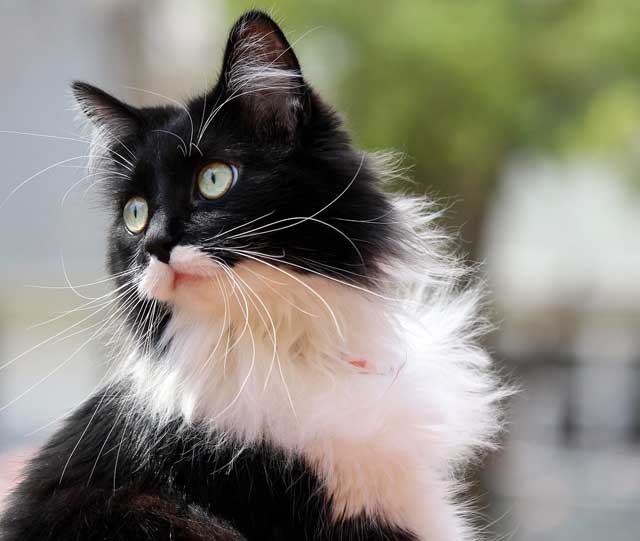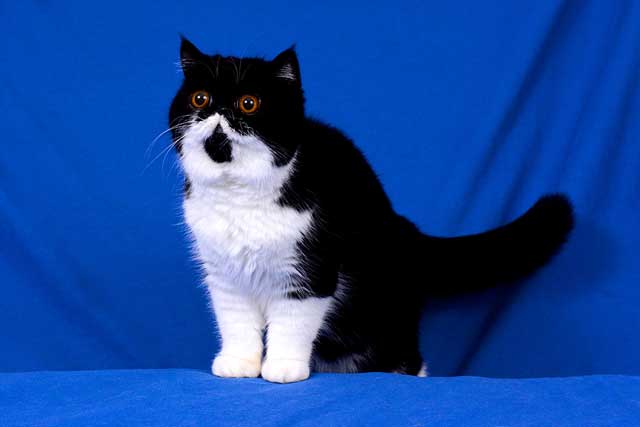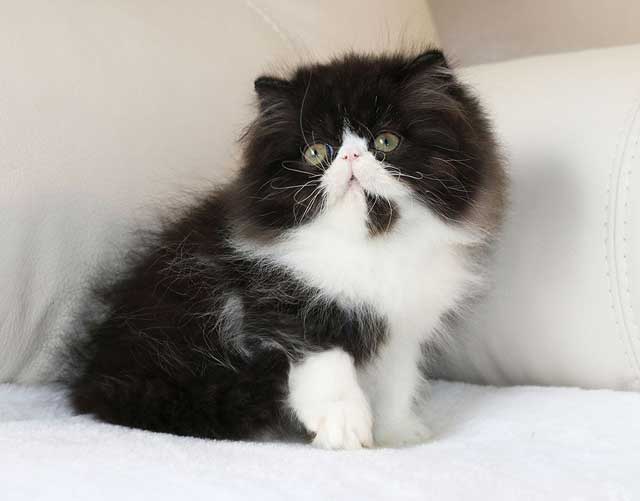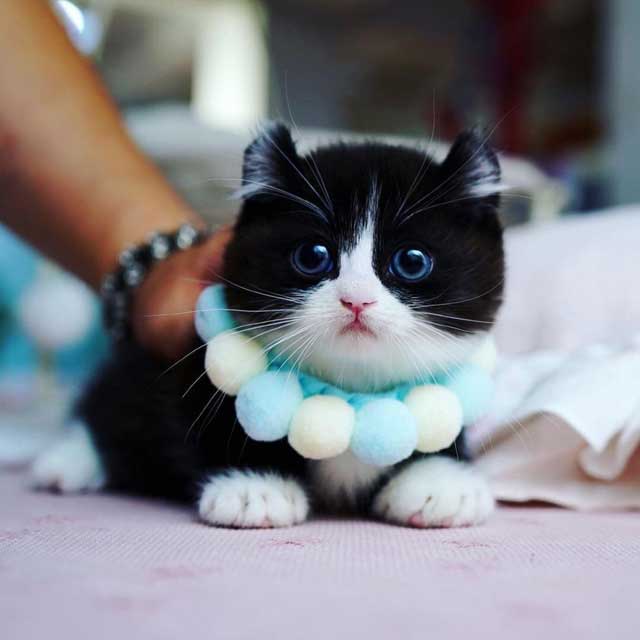What is a Tuxedo Cat? And 7 Common Breeds

What Breed is a Tuxedo Cat?
Tuxedo cats are not a cat breed, but a coat pattern that looks like a cat is wearing a tuxedo with a crisp white shirt. Tuxedo patterns are not limited to black, but the name is usually reserved for black and white cats. Typically, a tuxedo cat has a white chest, belly, and claws, while the rest of the body is black, gray, or orange.
This coat pattern can be found in many breeds of cats, including the Persian cat, American Shorthair, British Shorthair, Maine Coon, Manx cat, Norwegian Forest Cat, Scottish Fold, Turkish Angora, Turkish Van, and others.
How Much Does a Tuxedo Cat Cost?
A tuxedo cat shouldn't cost more than any other cat. Because tuxedo patterns are not particularly uncommon, and tuxedo cats are not members of well-known breeds, tuxedo cats are generally not more expensive than any other cat.
The cost of a tuxedo cat varies widely, from $500 to over $3,000, but the average price is around $1,000 to $2,000. Depending on the cat's breed and ancestry.
Here are 7 Common Breeds
Tuxedo cats are most commonly found among the Maine Coon, Norwegian Forest Cat, American Shorthair, British Shorthair, Exotic Shorthair, Persian cat, Munchkin cat, and Turkish Angora breeds.
1. Maine Coon Tuxedo
 PHOTO CREDIT: thehappycatsite.com
PHOTO CREDIT: thehappycatsite.com
Despite being one of the largest domestic cat breeds, it doesn't take much effort to keep a Maine Coon happy, and you'll find that a Maine Coon is relatively easy to care for.
What we know about a Maine Coon cat in a black and white tuxedo is that it is not very unusual compared to other Maine Coon colors and patterns, so it shouldn't cost that much.
Related: Maine Coon vs. Normal Cat: What is the Difference?
2. Norwegian Forest Cat Tuxedo

During World War II, the breed was almost wiped out by interbreeding, but members of the Norwegian Forest Cat Club united to establish a breeding program and restore the cat's popularity in Norway and beyond.
In general, the Norwegian Forest cat is a healthy breed, but like many purebred cats, the Norwegian Forest cat can suffer from several hereditary diseases that you will need to discuss in detail with the breeder.
3. American Shorthair Tuxedo

One of the most exciting features of the American Shorthair breed is the spectacular kaleidoscope of patterns and colors that the American Shorthair presents. If you're a first-time cat owner and want to start with a less demanding breed, this cat might be for you.
4. British Shorthair Tuxedo
 PHOTO CREDIT: Izzy & Zoë | Twitter
PHOTO CREDIT: Izzy & Zoë | Twitter
Like all felines, the British Shorthair is naturally independent, but the British Shorthair is especially known for being gentle, loyal and loving. But, if you don't have time to brush your cat and exercise it every day, this breed may not be right for you.
Related: Why is British Shorthair More Popular than American Shorthair?
5. Exotic Shorthair Tuxedo
 PHOTO CREDIT: artbygabi.wordpress.com
PHOTO CREDIT: artbygabi.wordpress.com
Today, this breed is one of the most popular cat breeds in America, second only to its cousin, the Persian. The Exotic Shorthair cat breed has the calm and friendly nature of the Persian cat, but is known for being a bit more playful and active, perfect for young families and the young at heart.
6. Persian cat Tuxedo
 PHOTO CREDIT: himalayan-persian.com
PHOTO CREDIT: himalayan-persian.com
The Persian cat has long been a favorite with cat lovers. It can be shown in many different colors and patterns, and there are even some new colorpoint varieties appearing now.
Persians are generally gentle and affectionate cats, but they will not tolerate rough treatment from children or other pets. They need plenty of attention and love to keep them happy.
7. Munchkin cat Tuxedo
 PHOTO CREDIT: scottishfoldmunchkin.com
PHOTO CREDIT: scottishfoldmunchkin.com
The Munchkin cat is a breed of domestic cat with a naturally occurring genetic mutation that causes the animal to have short legs. The Munchkin has an appearance that is similar to a small dog, and it is often compared to the Dachshund.
The Munchkin is one of over 300 naturally occurring short-legged cat breeds that have been documented worldwide. Although generally accepted as such, its name has been trademarked by TICA's parent organization, The International Cat Association, and other registries such as the American Cat Fanciers Association (ACFA) do not recognize it as a separate breed.
The Bottom Line
While the exact origins of the Tuxedo cat are unknown, it’s believed that they were first bred in the United States in the late 19th century. The black and white coloration was likely achieved by crosses between British Shorthairs and domestic black cats.
The Tuxedo cat became a popular household pet in the 1950s, thanks in part to its unique appearance and personality. And, they continue to be one of the most popular cat breeds today!
Tuxedos do not represent any particular breed of cat, but they are popular by that name due to their unique coat pattern. If you’re looking for a fun-loving and affectionate companion, a Tuxedo cat may be the perfect fit for you!
References
- [1] ^ YouTube: Tuxedo Cat 101: Everything You Need to Know
- [2] ^ The Spruce Pets: 7 Pawsitively Fascinating Facts About Tuxedo Cats
You May Also Like
 Breed Reviews10 Cat Breeds with Blue Eyes That Are Beyond Beautiful
Breed Reviews10 Cat Breeds with Blue Eyes That Are Beyond Beautiful Breed ReviewsThe 10 Best Cat Breeds for Cuddling
Breed ReviewsThe 10 Best Cat Breeds for Cuddling Breed Reviews10 Best Cat Breeds for First-Time Owners
Breed Reviews10 Best Cat Breeds for First-Time Owners Breed ReviewsThe 8 Least Aggressive Cat Breeds (Gentle Cat Breeds)
Breed ReviewsThe 8 Least Aggressive Cat Breeds (Gentle Cat Breeds) Breed Reviews10 Most Aggressive Domestic Cat Breeds
Breed Reviews10 Most Aggressive Domestic Cat Breeds Ranking Lists10 Cat Breeds That Live the Longest (Ranked)
Ranking Lists10 Cat Breeds That Live the Longest (Ranked)